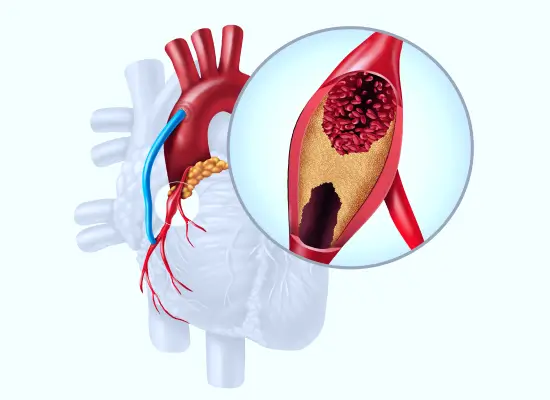Angioplasty is a minimally invasive procedure and serves as an effective alternative for major surgeries to treat conditions like coronary artery disease, angina, and peripheral artery disease.

Synopsis
The angioplasty surgery is a minimally invasive procedure that is used to open blocked or narrowed coronary arteries to improve blood flow. It is also called percutaneous coronary intervention, which is the PCI medical abbreviation. It helps to restore blood flow to the heart muscles without the need for open surgery. Gleneagles Hospitals is renowned for its laser angioplasty, which is highly effective in reducing the risk of heart attacks.
Introduction
Angioplasty procedure is minimally invasive and has many benefits for patients suffering from coronary artery disease or atherosclerosis (also known as hardening of the arteries). It is an effective heart blockage treatment without surgery that opens arteries and lets blood flow more easily. An angioplasty stent or tube is usually placed inside the newly opened space to keep it open. Angioplasty, including those with heart stent placement, is generally a safe procedure and less invasive than other heart and vascular procedures. Trust the best hospital for angioplasty like Gleneagles Hospitals for the effective results and recovery process.
What is Angioplasty?
Angioplasty treatment is a medical procedure that opens up arteries of the heart to improve blood flow and reduce the risk of heart attack, stroke, and other heart-related medical complications. Angioplasty involves a catheter with a balloon on the tip. The balloon is then inflated, which helps widen the arteries. The balloon is then deflated and removed. A stent in heart arteries is placed to help keep it open.
Types of Angioplasty
There are several types of angioplasty, each designed to treat specific heart conditions. Below are some of the most common types:
- Balloon Angioplasty: It is the most common type of angioplasty where a catheter with a small inflatable balloon is inserted into the affected arteries to widen them and push the plaque against the artery walls.
- Stent Placement: In this type, a stent is placed in the arteries to prevent them from narrowing again. When it comes to traditional angioplasty vs stent, traditional angioplasty involves a balloon, whereas heart stent involves placing a small mesh tube. They are often used in conjunction.
- Laser Angioplasty: Laser angioplasty is an advanced procedure where the laser is used to vaporise or remove the plaque buildup in the arteries. It is used in situations where balloon angioplasty or stenting might not be feasible.
- Megavac Angioplasty: Megavac angioplasty is an advanced procedure that removes blood clots from arteries. It is especially useful in cases, such as severe coronary artery disease, where there are significant blockages.
Your health matters – get expert advice today.
Why Choose Angioplasty Treatment?
Angioplasty is highly recommended for improving blood flow to the heart by opening narrowed blocked arteries. This minimally invasive procedure can potentially reduce chest pain, lessen the risk of heart attack and stroke, and serve as a great alternative to major surgeries like bypass surgery. Here are some common cases where angioplasty is needed:
- Coronary Artery Disease (CAD): Angioplasty is an effective treatment method for coronary artery disease or CAD, where plaque buildup in coronary arteries reduces blood flow to the heart.
- Angina: It is a medical term for chest pain. An Angioplasty procedure can relieve chest pain caused by reduced blood flow to the heart. It is especially useful when no other traditional treatment has shown any positive results.
- Heart Attack: In cases of heart attack, angioplasty can be performed as an emergency procedure to restore blood flow to the heart muscle. It is crucial in improving the chances of survival.
- Peripheral Artery Disease (PAD): Angioplasty can also be used to treat peripheral artery disease where narrowed arteries in the legs or arms lead to potentially serious complications.
Preparation for Angioplasty
Angioplasty treatment is used to open up blocked arteries to improve blood flow. Proper preparation is essential for a procedure without complications.
- Pre-Procedure Medical Evaluation Your doctor might recommend blood tests, ECGs, and imaging tests like coronary angiograms to understand the severity of the condition. You must inform your doctor about any medications you are taking. Do mention if you are taking blood thinners, diabetes medication, or some specific supplements.
- Medication and Dietary Guidelines Rigorously follow the instructions of your doctor regarding medication adjustment before the procedure. Avoid eating or drinking for at least 6-8 hours before the surgery.
- Lifestyle Adjustments Quit smoking and consumption of alcohol for a few weeks before the surgery to avoid unnecessary complications. Stay hydrated before you start fasting for the procedure. Practice mindfulness to reduce stress and get proper rest before the procedure.
- Day of the Procedure Wear loose and comfortable clothing and avoid wearing any jewellery. Arrive at the best hospital for angioplasty with the necessary documents and toiletries. Arrange for transportation after the surgery beforehand to avoid any last-minute hiccups.
Angioplasty Surgery Procedure
It is important to understand angioplasty procedure steps from your primary healthcare professional to mentally prepare yourself for the treatment. The coronary angioplasty procedure takes 30 minutes to 2 hours and is performed under local anaesthesia.
- Upon Arrival: After entering the hospital, you will be given a hospital gown. An IV channel will be inserted to provide sedatives and fluid. You will also be connected to monitoring devices to keep track of your vitals and oxygen levels.
- During Procedure: Your surgeon will give you local anaesthesia to numb the area of catheter insertion. Usually, the entry point is through the groin or the arm. The catheter will be entered and guided by a fluoroscopy machine. After reaching the targeted artery, the provider will briefly inflate the balloon on top of the catheter to widen the arteries. A stent is optional and might be placed as well to maintain a healthy blood flow.
- After the Procedure: After the procedure, you will be monitored for a period of time, depending on your overall health and recovery progress.

Recovery and Aftercare
Since angioplasty is a minimally invasive procedure, recovery is generally quick for most patients. However, one needs to take proper aftercare to ensure long-term wellness. After coming home, patients need to avoid heavy activities and driving for a while. It is important to keep the insertion area dry and clean and look for early signs of infections. Consume a rich, heart-healthy diet and avoid excessive salt or saturated fat. You can gradually resume light activities and exercises as per the doctor’s advice. If you are wondering what to avoid after a stent, quit smoking and alcohol for heart health.
Risk and Complications after Angioplasty
Even though angioplasty is a typically safe procedure, it does carry certain risks like any other treatment method. Here are some of the risk factors related to angioplasty.
- Bleeding: Heavy bleeding or bruising at the entry point of the catheter site is a common risk factor.
- Blood Clot: Blood clots can form at the site of the catheter entry point or within the treated artery. These blood clots travelling to the lungs can create a few complications.
- Infection: Infection at the catheter entry point is a possible complication and requires close monitoring.
- Restenosis: It is a medical term for narrowing of the surgery after the procedure.
- Heart Attack or Stroke: Rarely angioplasty can lead to heart attack or stroke.
Why Choose Gleneagles Hospital for Angioplasty?
Gleneagles Hospitals is well-known for its cardiac care services. From primary angioplasty to complex ones, we provide tailored treatment procedures to ensure the well-being of our patients.
- Expert Cardiologists: Our expert cardiologists are committed to patient-centric care.
- State-of-the-Art Facilities: The hospital has advanced cath labs and diagnostic facilities to provide all-around care.
- Minimally Invasive Techniques: Gleneagles Hospitals emphasise minimally invasive techniques to reduce complications.
- World-Class Infrastructure: Our advanced operating rooms and recovery units are designed for patient comfort.
- High Success Rate: The hospital has a proven record of excellent patient outcomes and high satisfaction rates.
Frequently Asked Questions
An angioplasty stent is used to keep the blocked arteries open and maintain a healthy blood flow.
Patients are able to return to their regular activities within a week or two of the angioplasty procedure.
The angioplasty procedure takes anywhere between 30 minutes and 2 hours.
Some of the common risk factors of angioplasty are bleeding, infection, blood clots, restenosis, heart attack, or stroke.












